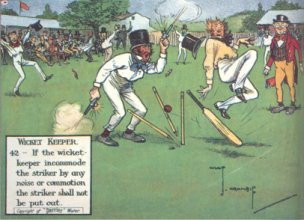Tired of ‘Need a bell in that mate?’, ‘Big swing, no ding’, and ‘3 runs till the next batting point, make yourself a hero’? Here’s some suggestions for you to try next time.
Sledge 1, the Magnus effect.
Imagine for a moment you are a spinner, you’re getting big drift and the batsman is frequently being deceived in the air. Imagine then the confusion you could cause by uttering to the wicket keeper the
following, ‘Can’t handle the old Magnus effect, can he?’. This apparently absurd statement is actually true though. The Magnus effect comes about as a spinning object creates a kind of whirlpool of air
spinning around itself. On one side of the object, the motion of the whirlpool will be in the same direction as the wind stream that the object is exposed to. On this side the velocity will be increased. On
the other side, the motion of the whirlpool is in the opposite direction of the wind stream and the velocity will be decreased. As one side of the ball is now effectively travelling marginally faster than the other the ball will curve in flight. This is the cause of the natural drift that spinners obtain.
Be warned however, an all too common misconception is that the Magnus effect is also the cause of the ball swinging, this is not the case however, which leads us nicely onto number 2.
Sledge 2, delayed separation of the wake.
‘Great wake separation mate, keep it there’ is a cry that you rarely hear from wicketkeepers these days, but maybe you should.
Most swing bowlers bowl at a speed that means that the airflow around the ball is a mixture of laminar flow, and turbulent flow. If you bowl above about 90mph all flow around the ball becomes turbulent and swing becomes more difficult to obtain. However slower than this and over some parts of the ball the flow is laminar, whilst over others the flow is turbulent. The key to successful swing bowling is managing this flow over the ball. By leaving one side of the ball rough turbulent air flows over this side. Whilst over the other smooth side there will be laminar flow. Turbulent flow generally ‘clings’ to the side of an
object more, this means that there is delayed separation on the rougher side and hence the ball will tend to swing towards it.
Sledge 3, simple projectile mechanics.
Imagine you’ve been hit for a v.big six, yes we’re back here again. If you’ve ever seen me bowl you’ll realise why this is a recurring theme.
Now however big the 6 is it’s very unlikely that the batsmen hit at at the optimum angle. Assuming there is negligible effect from air resistance then this angle should be precisely 45 degrees to the horizontal. If you take the effect of air resistance into account the optimum would probably be somewhere between 40 degress and 45 degrees. Simply utter. ‘Cracking shot buddy, but that would have gone far further if you’d hit it at an angle of exactly 45 degrees’. Next ball you’re now guaranteed that the batsmen will attempt to hit the ball at said angle. It’s really really unlikely he’ll hit it at precisely this angle even if he has 100 goes, and even if he does it’ll be tough for him to prove it, hence the sledge can be pretty much used ad infitum.
Sledge 4, the linear vector.
Imagine you are facing a bowler who’s doing very little with the ball on a road of a pitch and you’re in good form. As you flay away another ball to the boundary have you ever thought of uttering the words.
‘Excuse me mr Bowler, ignoring the acceleration due to gravity did you realise that it’s considerably easier to intercept a ball where the component of acceleration is in the same direction as the velocity, in
effect it’s just a linear vector’?
No, you probably haven’t, to be honest you’re probably not that much of a loser, but imagine the chaos you could cause inside that bowlers head and you’re speaking only the truth. Okay you could be the subject of ridicule from behind the stumps, you could cause great mirth in the slip corden, but that only serves you well as it significantly increases the chances of them dropping the next chance.
Sledge 5, the run rate sledge.
Practice your division until you can work out run rates to at least 1 decimal place. Then at an oppertune moment take the time of saying to the batting side, ‘your current run rate is….., in order to win you
now need a run rate of…., good luck’. At this point you can see that it probably doesn’t matter if the run rates you utter are right at all. But this is after all intelligent sledging!!
Happy Sledging,
Onefa.





